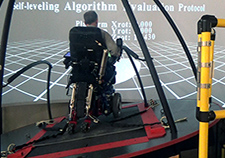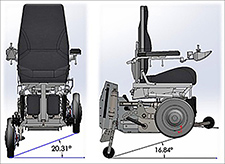Office of Research & Development |
 |

VA Research Currents archive
February 3, 2016

Testing of the MEBot involves a large mechanical platform that tilts and lurches in various directions. (Photo courtesy of HERL)
It has six wheels, an onboard computer and software, and an array of high-tech sensors and actuators. It's designed to smoothly navigate over gravely or muddy roads, uneven slopes, wet grass, and other difficult terrain.
No, it's not the latest rover from NASA or military vehicle from DARPA.
It's a robotic wheelchair being designed, built, and tested at the Human Engineering Research Laboratories (HERL), with input from Veterans who use wheelchairs. HERL is based at the VA Pittsburgh Healthcare System and the University of Pittsburgh.
The new device is called MEBot. The group recently described the work in the journal Medical Engineering and Physics.
The model is still in development. So far it's been tested only at HERL, using equipment such as a 180-pound test dummy and a large elevated mechanical platform that tilts and lurches in all sorts of directions. It's not quite the mechanical bull at Gilley's in Dallas, but it's robust enough to simulate a fairly rugged outdoor excursion.
The device still has to go through rigorous user testing, both in the lab and in the field. Even if all goes well in further tests, the MEBot probably won't be ready commercially for another five years or so, says Cooper.

The graphic shows the maximum cross slope and up/down slope angles of the MEBot. (Photo courtesy of HERL)
But he is enthusiastic about what the device could mean for Veterans and others who depend on wheelchairs to get around. He says it would give them unprecedented freedom and independence, as a daily mobility device both in the great outdoors and inside homes, shops, and offices.
"MEBot can go up or down curbs or steps, and maintain a level seat—forward, backwards, and left and right—over uneven terrain," says Cooper. "It has traction control, anti-skid braking, and all the features of an electric powered wheelchair with powered seat functions—tilt, recline, leg-rest, elevation. It's highly functional indoors and outdoors, in both ADA [Americans with Disabilities Act] and non-ADA environments."
The self-leveling feature is crucial because it keeps the chair from dangerously spilling its driver onto the ground when traversing rough, sloping, or otherwise uneven surfaces, including ramps and curb-cuts.
The inner workings of this feature, like just about every other aspect of the chair, are complex but elegant. Various sensors detect the positions of the seat, the wheels, and the electric and pneumatic actuator motors that control them. Algorithms programmed into the MEBot instantaneously analyze the sensor input and determine the desired position of the actuators in order to keep the seat level.
"It's highly functional indoors and outdoors, in both ADA and non-ADA environments."
A key feature of the MEBot is its six wheels—two compact but muscular drive wheels on either side, along with smaller front and rear casters on either side. Each wheel can pivot up or down, independent of the others, and the drive wheels can also adjust backwards or forwards.
Picture someone trying to maneuver the chair along the side of a hill, on a slight angle: The wheels on one side of the chair could be a full 20 degrees lower than their counterparts on the opposite side, to help keep the seat level. Cooper uses the term "float" to describe how the seat—and the user on top of it—maintain their center of gravity amid pitching, rolling, and yawing.
Curbs? No problem. The onboard curb-climbing app kicks in automatically when it senses a curb or step. It leverages the up-and-down motion of all six wheels, and the forward motion of the drive wheels, to mount the curb while keeping the chair and its user stable.
Cooper says MEBot is designed to handle curbs up to 8 inches high.
The mammoth East Coast blizzard of late January notwithstanding, MEBot should also allow users to avoid getting stuck on snow or ice. The unit is surprisingly agile for its 365 pounds: It can balance on its two drive wheels, like a Segway. Also, the drive wheels can be repositioned to help regain traction. Plus, the traction-control app senses when a wheel or two have lost their grip on the ground and adjusts other components to maintain the desired course.
Curb navigation was one of the top issues that came up in HERL focus groups with Veteran wheelchair users. They talked, for example, about having to drive their chair in the street—putting themselves at risk—when they were in areas that lacked curb-cuts at the corners.
The discussions, reported last year in JRRD, continue to guide the MEBot team, which includes a range of disciplines: electrical, computer, and mechanical engineering; robotics; physical and occupational therapy; and biomechanics.
But all the scientific and engineering prowess aside, at the center of the design process are "end users—the Veterans—and their families," says Cooper. "We have sought feedback regularly."
That process will continue as the team now launches preliminary user testing at HERL. They still have several design tweaks to make, and a second-generation prototype is in the works.
The group is awaiting a decision on a patent application for MEBot, and they are planning to apply for VA funding to further develop the model. So there's still a long road ahead.
But that doesn't mean the MEBot will be sequestered in HERL's facilities for long. Cooper is planning to debut the prototype at the international Cybathlon competition for athletes with disabilities, to be held in Switzerland in October 2016.